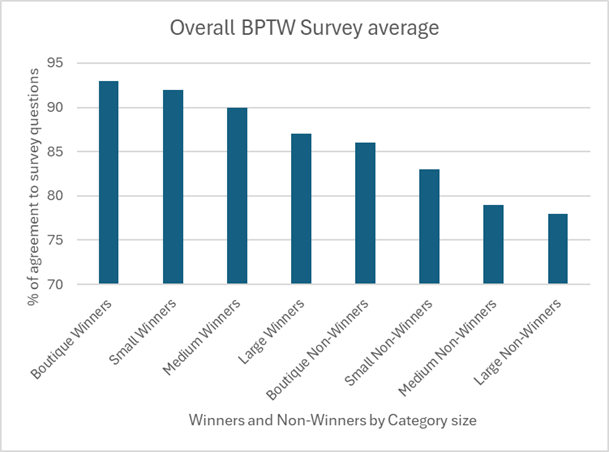

News & Insights | 6th June 2025
Employee Benefits
7 Min Read

With Campaign’s Best Places to Work Awards behind us for another year, we’ve taken a look at where the 2025 prizes were won. The awards shine a light on businesses within the creative and media related sectors that are setting the standard for great workplace cultures. As longstanding partners of the awards and employee benefits specialists, we naturally pay particular attention to the ‘employee benefits’ section of the survey, but all the results are interesting in understanding what helps keep teams happy and motivated.
For those who haven’t come across the awards before, there are four company size categories – boutique, small, medium and large. Campaign announces a Top 100 list, the Top 5 companies from each category, and then an overall winner from each category. Results are based on the responses to an anonymised survey completed by employees.
Where the winners stand out
In contrast to non-winners, companies that prioritise employee wellbeing with a robust benefits strategy continue to reap the rewards together with markedly higher positive scores regarding the benefits they provide.
Across all size categories, the average positive response to employee benefits for winners was 78.9%, compared to 67.2% for those who weren’t. This 11.7% difference underscores not just how critical a comprehensive benefits package is to employee satisfaction but also how well it is communicated internally.
The Boutique category (15–24 employees) saw the largest disparity, with winners reporting 87.5% satisfaction compared to 65.6% for those who missed out. At the other end of the spectrum, large companies (150+ employees) showed a smaller gap, though still notable—75.4% for winners vs 69.0% for the field.
This does raise the question of how those larger companies can continue to harness a positive culture which is naturally easier to deliver in smaller businesses. Conversely how can smaller companies continue to deliver a strong benefits package despite the lack of scale and buying power in an inflationary benefits market.
So does size really does matter?
This year’s survey results really do highlight the challenges faced by larger organisations when it comes to maintaining a strong culture and happy workforce.
Arguably this isn’t a revelation, there are plenty of studies that show everything from increased bureaucracy and poor communication to inflexibility and loss of the individual’s sense of recognition that can blight an employee’s sense of value and wellbeing.
These issues go far beyond creative-related businesses, but the graph below does show an uncanny correlation between overall employee satisfaction and the size of the company they work for. From left (‘Boutique Winners’) to right (‘Large Non-winners’) and without exception, every bar on the chart for both winners and non-winners gets smaller as the size of business gets bigger.

So is there anything larger organisations can do to compete with their smaller and more agile competitors? Happily for them the answer is yes, and we take a separate look at eight suggested action points in this article: When it comes to company culture, does David always beat Goliath?
When it comes to the role of employee benefits and their impact on this year’s survey results, three things stood out.
Private Healthcare
Private healthcare continues to be one of the most in demand benefits, particularly as NHS wait list times remain a concern. Survey data shows that 85.7% of employees at winning agencies rated their private healthcare benefit positively, compared to 75.3% among non-winners. Boutique agencies again saw the largest gap, with 89.2% of employees at winning businesses rating the healthcare benefits they receive positively versus just 60.9% for those who didn’t pick up a win this year.
These results point to the growing demand for accessible and effective healthcare options. Employers offering well-structured private medical coverage are not only supporting their employees’ wellbeing but ensuring that absence remains in check as people can be seen and treated in a timely manner. Full private healthcare packages can be a budgetary challenge for smaller companies, but entry level cash plans can help bridge this gap.
Pensions
Retirement benefits continue to be an area where employers seem to be struggling to meet employee expectations when compared with other benefits. Among winners, only 64.9% of employees gave a positive response regarding their pension schemes, compared to 58.7% for the rest.
In the large employer category, this number drops to 60.2% among winners—the lowest among all benefits surveyed. This suggests a disconnect, possibly due to poor communication or a lack of engagement with the benefit itself. We see that by educating employees about the long-term value of their pension schemes and simplifying access and management tools can make a tangible difference.
Overall Trends in year-on-year benefits perception
Interestingly, overall satisfaction with ‘employee benefits’ was again the lowest rated section in the survey—even among winners—suggesting that while culture and work practices are improving, some rewards are lagging behind. In contrast, areas such as ‘relationship with your manager’ and ‘diversity and inclusion’ scored notably higher.
This indicates a strong need for employers to not only invest in quality benefits but also ensure they are clearly communicated and tailored to employee needs. Even the best benefits package will fall flat if it’s not understood or appreciated. However, the elephant in the room is of course keeping to budget, but it doesn’t always need to be a new expensive benefit which makes the difference, but promoting and utilising the services already available to the agency via existing plans can make a real difference.
Conclusion
This year’s data reinforces a clear message: employee benefits play a central role in shaping workplace culture and business success. Agencies that listen, adapt, and communicate effectively are leading the way.
We are proud to continue supporting Campaign’s Best Places to Work Awards and look forward to helping even more employers build workplaces where people truly thrive.
The Best Places to Work survey research is conducted on behalf of Campaign by the Workforce Research Group and comprises nine sections and 73 questions. Results are based on confidential employee feedback and analysed by winning status and company size.